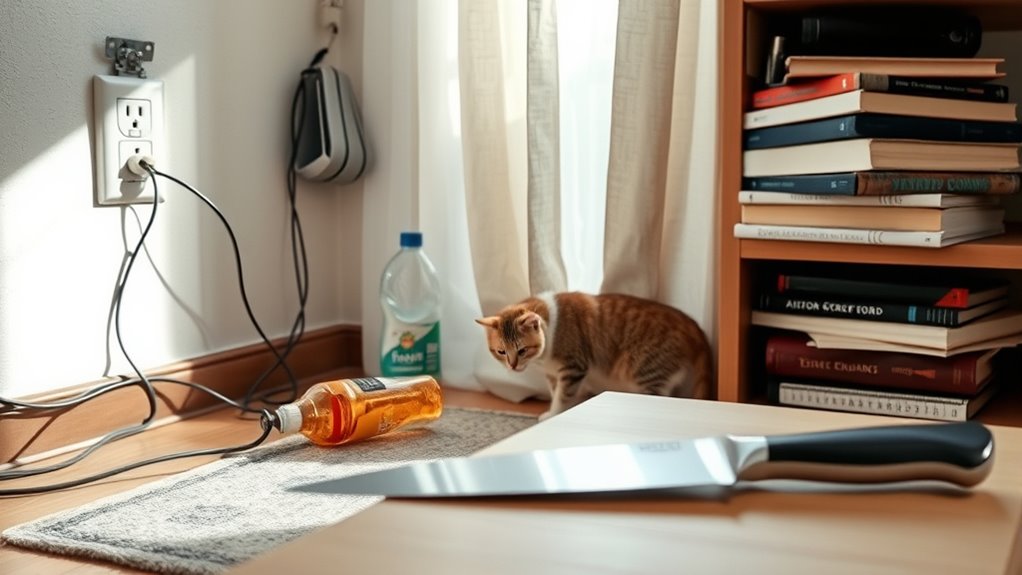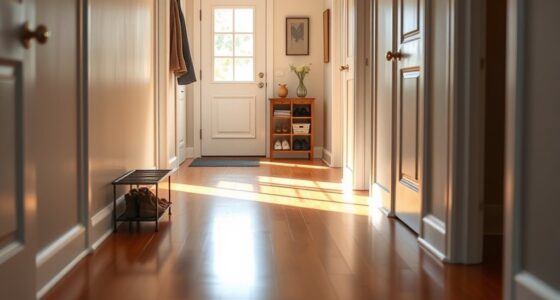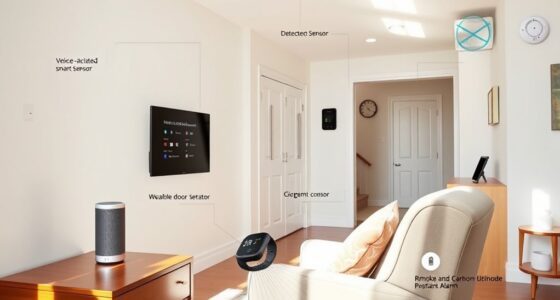To identify common household hazards, start by inspecting your home for fire risks like overloaded outlets and working smoke detectors. Check chemical storage to make certain cleaners and chemicals are labeled and out of children’s reach. Look for clutter, loose rugs, and unstable furniture that could cause trips or falls. Examine electrical cords and outlets for damage and avoid overloading sockets. Addressing these hazards now helps create a safer environment—continue exploring to discover practical tips for a hazard-free home.
Key Takeaways
- Regularly inspect for clutter, loose rugs, or unstable furniture that could cause trips or falls.
- Check electrical cords and outlets for damage, wear, or overloading hazards.
- Identify potential fire risks, such as overloaded outlets, unattended heat sources, or flammable materials near heat.
- Ensure chemicals and cleaning supplies are stored securely and away from children and pets.
- Assess lighting in all areas to prevent accidents and ensure visibility of hazards.

Household hazards can pose serious risks if you don’t recognize them early. Being aware of potential dangers around your home helps you prevent accidents before they happen. One of the most critical areas to focus on is fire safety. Check your smoke detectors regularly—replace batteries at least once a year and test them monthly. Keep a fire extinguisher in accessible spots, like the kitchen and garage, and ensure everyone in your household knows how to use it. Be cautious with electrical outlets; avoid overloading sockets, and unplug devices when not in use. Keep flammable items, such as paper, cloth, and cleaning supplies, away from heat sources like stovetops, heaters, or candles. These simple steps can considerably reduce the risk of a fire starting unexpectedly.
Another common household hazard involves chemical storage. Many homes contain cleaning products, paints, and other chemicals that can be dangerous if mishandled or stored improperly. Always store chemicals in their original containers with clear labels, and keep them out of reach of children and pets—preferably in a locked cabinet. Avoid storing chemicals near food or drink to prevent accidental ingestion. Be mindful of how you dispose of these substances; follow local regulations to prevent environmental contamination or harm to others. When using chemicals, wear protective gear like gloves and masks, and ensure proper ventilation. Proper chemical storage not only prevents accidental poisoning but also reduces the chance of spills that could lead to slips or other injuries. Incorporating proper storage practices can significantly minimize household risks.
Beyond fire safety and chemical storage, pay attention to clutter that can cause trips and falls. Clear walkways and keep cords tucked away to avoid tripping hazards. Regularly inspect your home for loose rugs or unstable furniture that could cause accidents. Make sure your stairs have secure handrails and adequate lighting. Small hazards often go unnoticed but can be the source of serious injuries. Address these issues promptly, and teach everyone in your household about safety precautions. Recognizing hazards early gives you the power to address them before they turn into emergencies. Staying vigilant about fire safety and proper chemical storage is an essential part of maintaining a safe home environment. When you take these steps, you’re actively protecting yourself and your loved ones from preventable accidents and ensuring a safer living space for everyone.
Frequently Asked Questions
How Often Should I Inspect My Home for Hazards?
You should inspect your home for hazards at least once a month to guarantee ongoing home safety and hazard prevention. Regular checks help you spot potential dangers like loose rugs, faulty wiring, or clutter that could cause falls or injuries. Be especially vigilant in high-risk areas such as the kitchen and bathroom. Staying proactive with home safety measures reduces accidents and creates a safer living environment for everyone.
Are There Specific Hazards Unique to Certain Age Groups?
Think of your home as a safety map, with different hazards marking unique landmarks for each age group. You’ll find age-specific hazards like choking risks for children, slip hazards for seniors, and poisoning dangers for teenagers. Knowing these lifecycle risks helps you identify hazards tailored to their needs. For example, installing stair gates for kids or grab bars for elderly residents ensures you protect everyone at every stage.
What Tools Can Help Detect Hidden Household Dangers?
You can use detection devices and hazard sensors to spot hidden dangers around your home. These tools help identify risks like smoke, carbon monoxide, gas leaks, or water damage before they become serious. Install smoke alarms, carbon monoxide detectors, and moisture sensors in key areas. Regularly check and maintain these devices to guarantee they work properly, giving you peace of mind and a safer living environment.
How Can I Prioritize Which Hazards to Address First?
You should start with a risk assessment to evaluate each hazard’s potential danger. Use hazard ranking to prioritize issues based on severity and likelihood of occurrence. Address the highest risks first, such as fire hazards or electrical problems, then move on to less critical concerns. This approach guarantees you’re tackling the most dangerous hazards promptly, creating a safer home environment without wasting time on minor issues.
Are There Common Hazards I Might Overlook in My Home?
You might overlook hazards like fire safety risks from overloaded outlets or frayed cords and electrical risks from outdated wiring. Always check behind furniture for hidden fire hazards and verify smoke detectors work properly. Don’t forget to inspect your electrical system regularly, especially in older homes. Keeping these areas in mind helps prevent fires and electrical accidents, making your home safer and less prone to unexpected dangers.
Conclusion
By staying alert and aware of common household hazards, you can substantially reduce the risk of accidents. Remember, nearly 60% of home injuries happen in the kitchen or bathroom, highlighting the importance of vigilance in these areas. Regularly inspecting your home and practicing safety habits can make a real difference. Stay proactive, keep hazards in check, and create a safer environment for everyone in your household. Your awareness can truly save lives.








